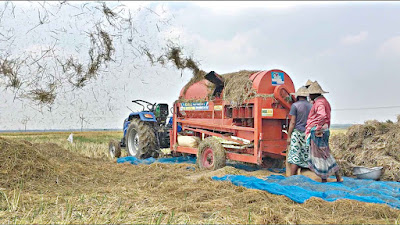Boro Farming in Barind: Hope lost in debt woes
This article first appeared on The Daily Star
The yield was good, the weather was favourable for harvesting Boro paddy and the prices too were acceptable, if not fair, to farmers.
Still, the harvest failed to bring smiles to the faces of most small and marginal farmers in the Barind region as they can only expect to take less than one fifth of their harvest home after paying off loans and the landowner's share.
Alfaz Uddin, for example, harvested Boro paddy from 1.34 hectares of land at Kashimpur Beel. He owns only 0.27 hectares of it and the remaining 1.07 hectares he took on lease.
"My share of paddy is very little," the 50-year-old farmer told The Daily Star, while gazing at the heap of ripe Boro paddy on his land.
A small farmer, Alfaz hoped the total production would be around 8.21 tonnes from the land. "But I will be able to take home no more than 1.5 tonnes of paddy after paying all the expenses including loans and the landowner's share," he said.
"The lion's share will be spent on repaying loans."
He had to pay the wages of labourers with paddy, share paddy with the landowner, and repay high-interest loans he had borrowed for buying seeds, fertiliser and pesticides during cultivation.
"I have also taken a loan of Tk 40,000 from a bank. All these will take away 80 percent of my paddy," he added.
Asked how he is going to survive with this trivial share, Alfaz said, "I will keep some rice for my own consumption and sell the remaining small portion to buy household necessities and meet the cost of cultivating other crops."
During this conversation, he asked whether this correspondent could arrange an interest waiver on his bank loans.
Alfaz further said one tonne of dried paddy sold at Tk 26,000 and moisturised paddy at Tk 23,750, while he was harvesting last month.
Kashimpur Beel falls under Godagari upazila of Rajshahi and the 16 northern districts in the greater Rajshahi division comprise the Barind region.
According to Department of Agricultural Extension (DAE) data, out of around 44 lakh farmers in the region, 35,79,118 or over 81 percent are small and marginal farmers.
While visiting Godagari in late May, this correspondent came across farmers harvesting their crop fields. Some were cutting late sown paddy, some threshing the harvested paddy and winnowing those with locally made machines, and some weighing the paddy before transporting those in sacks. Others were drying the straws and selling those from the field.
Many farmers echoed Afzal's comments, saying their shares of the produced paddy were not sufficient for their needs despite good yields. They said it will only help them somehow survive but is never enough.
Sohel Rana, a farmer who has no land of his own, cultivated Boro on 0.5351 hectares of leased land in Sabdipur village.
He said the produce from 0.4013 hectares would be spent on paying off debts, labour and transport costs and the landowner's share. He will be able to take home little less than the yield of 0.1338 hectares, one fourth of his total leased land
Whatever is supposed to be left after paying off everything will never be sufficient for his family's consumption all year, and he will have to depend on Aman next to survive.
Several other farmers gave similar statements and said their only thoughts were how much paddy they will be able to take home. They were trying to recover losses of paddy cultivation by selling off the straw, the price of which has increased in recent years.
The straw, which never sold above Tk 1,000 per thousand small stacks, now sells between Tk 5,000 and Tk 12,000, added the farmers.
Agriculturists say small and marginal farmers who have to borrow money for cultivation are never able to take home more than 20 percent of their paddy.
Sellers of agricultural inputs, rice mill owners and middlemen in the rice business provide loans to the farmers and they have to pay off their loans with paddy, they said.
"Most of our farmers suffer losses for their inability to afford the high expenses of Boro cultivation," said Prof Raihan Habib, agricultural economist of Bangladesh Agricultural University.
"They [small and marginal farmers] borrow and while repaying, they cannot wait with their produce for a price increase. Sometimes, they have to pay off their lenders with paddy from the field at lower prices," said Habib, who also oversees paddy farming on more than 28 hectares of the university's land in Mymensingh.
Sirajul Islam, additional director of the Rajshahi regional DAE office, said they recorded an average yield of 4.43 tonnes of rice on every hectare of land in the hard Barind region of Chapainawabganj, Rajshahi, Naogaon and Natore districts until early June, with 99.84 percent of the paddy harvested.
"When the harvest season ends by the middle of June, the yield will increase," he said.
This year, the DAE expects more than 16 lakh tonnes of rice production from the four districts and a total of 2.5 crore tonnes of Boro rice across the





Comments
Post a Comment